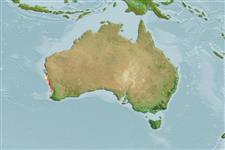>
Gobiesociformes (Clingfishes) >
Gobiesocidae (Clingfishes and singleslits) > Cheilobranchinae
Etymology: Alabes: Greek, alabes, oy = a fish from the Nile, dealing with lampreys (Ref. 45335); gibbosa: Named for the hunch-backed appearance of the species (B. Hutchins, pers. comm. 05/05/06).
Environment: milieu / climate zone / depth range / distribution range
Ecologia
marinhas demersal; intervalo de profundidade 2 - 4 m (Ref. 56640). Subtropical
Eastern Indian Ocean: Western Australia.
Tamanho / Peso / Idade
Maturity: Lm ? range ? - ? cm
Max length : 9.1 cm SL macho/indeterminado; (Ref. 56640)
Descrição breve
Chaves de identificação | Morfologia | Morfometria
Diagnosis: Pelvic fins rudimentary. Gill slit medium. Postocular pore 2, wide; anterior nasal and lacrymal pores present; posterior nasal pore absent. Vertebrae total 60-61, precaudal 22; last epineural on the 20th vertebra. Caudal rays 9-11. Dorsal origin over the anus. Body not transparent. This species differs from it congeners by a combination of its deep body (depth 7.8-9.5 in SL), which usually exhibits a gibbous dorsal profile, relatively large gill slit (3.3-3.9 in HL), large gill slit (2.9-4.4 in HL), prominent rudimentary pelvic fin with obvious fin rays, two postocular pore on each side of head, and unique color pattern. It is most similar to A. brevis, differing in its deeper and larger body, presence of a post nasal pore (usually absent in the latter species), more vertebrae (68-69 versus 61-62), and different coloration, where males of this species never develop a tigerlike pattern of irregular dark bars on the side of the head as found in A. brevis (Ref. 56640).
Collected from shallow coastal waters, in seagrass areas (Ref. 56640).
Life cycle and mating behavior
Maturidade | Reprodução | Desova | Ovos | Fecundidade | Larvas
Hutchins, J.B. and S. Morrison, 2004. Five new species of the genus Alabes (Gobiesocidae: Cheilobranchinae). Rec. Australian Mus. 56:147-158. (Ref. 56640)
Categoria na Lista Vermelha da IUCN (Ref. 130435: Version 2024-1)
Ameaça para o homem
Harmless
Utilização humana
Ferramentas
Relatórios especiais
Descarregue XML
Fontes da internet
Estimates based on models
Preferred temperature (Ref.
123201): 16.9 - 22.7, mean 18.3 °C (based on 89 cells).
Phylogenetic diversity index (Ref.
82804): PD
50 = 0.5005 [Uniqueness, from 0.5 = low to 2.0 = high].
Bayesian length-weight: a=0.00102 (0.00046 - 0.00225), b=3.06 (2.88 - 3.24), in cm total length, based on all LWR estimates for this body shape (Ref.
93245).
Nível Trófico (Ref.
69278): 3.4 ±0.3 se; based on size and trophs of closest relatives
Resiliência (Ref.
120179): Médio, tempo mínimo de duplicação da população 1,4 - 4,4 anos (Preliminary K or Fecundity.).
Fishing Vulnerability (Ref.
59153): Low vulnerability (10 of 100).
